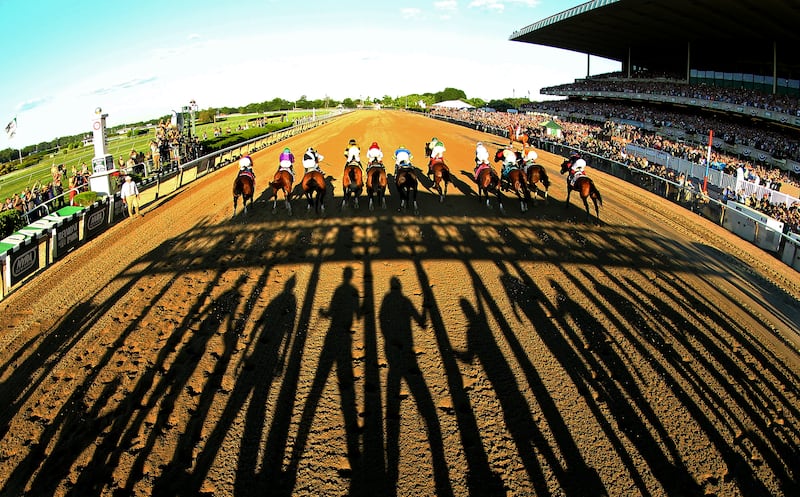The most fitting outcome of the 155th Belmont Stakes in New York next Saturday night would be a victory for Bob Baffert’s National Treasure. Following his success in the Preakness last month, Baffert will be running a contender at the New York venue for the first time since serving a lengthy ban for drugging his horses. Multiple times. What could be more appropriate for a beleaguered sport under fire for the number of animals dying on tracks than its most controversial trainer seeing his charge endure over the 1½-mile course known as “the test of champions”.
While racing folk are thrilled that the Belmont features the strongest field of three-year-olds assembled this year, those outside the game (the vast majority of Americans) are wondering why, given how many horses are perishing, these races are being run at all. The Kentucky Derby, the first leg of the fabled Triple Crown, was a damp squib on the first Saturday in May, beset by 11th-hour withdrawals due to injuries and illness, and Saffie Joseph Jr scratching Lord Miles because the trainer was suspended after two of his other horses collapsed and died while competing there that very week. The whole event reeked.

The Preakness, the second jewel in the Crown, was an equally lacklustre affair with a field of just seven runners, the smallest in 37 years. Now, the lengthier build-up to the Belmont has been overshadowed by storied Churchill Downs, fresh from hosting the Derby, temporarily closing its gates to try to figure out why 12 horses have died at the Kentucky track since April 12th. A number staggering enough to put the locals off their mint juleps. Authorities are investigating potential causes that include over-prescribing drugs, the cushion content of the track, and the adverse impact of rain.
[ Baffert’s serial doping and risible excuses a sad indictment of American racingOpens in new window ]
“Every time the industry comes under intense scrutiny for what is perceived to be a spate of killing (remember, Churchill averages 25 kills annually; at 12 thus far, right on course),” wrote Patrick Battuello, the man behind horseracingwrongs.org, a website assiduously cataloguing the spate of deaths at American tracks, “the powers that be come out and reassure that nothing is more important than the welfare of their ‘athletes’, that no stone is being left unturned, that all safety protocols are being re-evaluated, that full necropsies and in-depth analyses of the deaths are being conducted ... Meanwhile, the horses continue to die.”
Gordon D’Arcy: Munster parting ways with Graham Rowntree is a massive gamble
Is the Manchester United job too big a risk for Rúben Amorim?
Graham Rowntree has left Munster. These six games define his tenure at the province
Conor Purcell heads to Challenge Tour finale with DP World Tour card guarantee
That such a website exists, offering a trove of forensic, depressing detail about the circumstances surrounding the demise of every animal in the past decade (an estimated 2000 per year), tells its own story about the troubling state of horse racing in America. Battuello’s case is further illustrated by the fact four horses have died while either competing or training at Belmont Park in the past three weeks alone, taking the death toll there to 16 for the calendar year. Troubling statistics that are hardly likely to feature in the gushing television coverage on Fox next Saturday. There’s a much better chance of somebody trotting out the racing industry’s contention that the game has never been safer.
For the opening day of racing four weeks ago, 2,120 punters paid the $5 (€4.67) entry fee into Belmont Park. The track is located on Long Island (population 8 million) and the average daily attendance for the season will be just about twice that of the opening day. Paltry numbers that show most Americans care little and know less about horse racing, only ever turning their eyes to it for the three Saturday evenings of the Triple Crown. The same way Irish people tune in for the Grand National and Cheltenham and tune out all the stories about how utterly dodgy the whole business seems to be.

A crucial difference between the sport here and in Ireland is that it doesn’t get mainstream media coverage outside these marquee events, scarcely warranting column inches and rarely gatecrashing television sports bulletins. The latter may explain how, even as the rest of American sport belatedly addressed the issue of steroids, trainers were still routinely doping horses with Lasix, a deadly performance-enhancing drug that was legal until 2021.
It’s easy to see why some regard racing as a place where unscrupulous owners and trainers, more concerned with potential glory than animal welfare, will do anything to get their horses to the starting gate. Never mind the death toll, feel the wins. This may also explain why more than 40 American tracks have closed this century, attendance at some venues is down 80 per cent, and The Economist asked recently, “Is horse racing in America on its last legs?”
Other outlets wonder whether it might yet go the way of greyhound racing, a sport on the brink of extinction. As recently as the 1980s there were 50 greyhound tracks across 19 states. There are now two, the rest shuttered by declining public interest and animal rights protesters raising hell about the mistreatment of dogs. Horse racing is a lot bigger and more politically influential (the Governor of New York recently pledged half a billion to improve Belmont) but the trend lines are remarkably similar.
“The thoroughbred racehorse is a genetic mistake,” wrote Bill Finley in the New York Daily News back in 1993. “It runs too fast, its frame is too large and its legs are too small. As long as mankind demands that it run at high speeds under stressful conditions, horses will die at racetracks.”
As accurate an assessment then as it is now.






